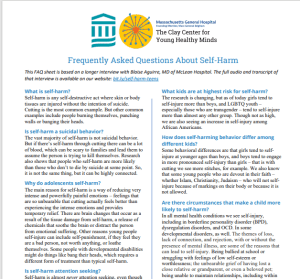My Child Is Deliberately Cutting. What Do I Do?

Posted in: Teenagers, You & Your Family, Young Adults
Topics: Behavioral Issues, Mental Illness + Psychiatric Disorders
Learning that your child has been engaging in self-harm can be really scary and alarming as a parent or guardian. We answer a parent’s question, below.
Hear a detailed conversation about underlying causes and how to respond to self-harm in a child below, or find “Shrinking It Down” wherever you stream.
Question: My child is deliberately cutting herself. What do I do?
Dr. Schlozman’s Answer:
When I was in the first year of my psychiatry residency:
- I learned that patients sometimes cut their own skin.
- I learned that some people take sharp objects and make (mostly) superficial cuts on their forearms or legs, or elsewhere on their bodies.
- I learned that these patients would wear long sleeves if they had cut their arms, and long pants if they had cut their legs. They didn’t, it seemed, want others to know that they had cut themselves; they were ashamed.
- I even learned that on inpatient units, some patients would go to impressive lengths to obtain sharp objects with which to make their minor and repetitive incisions.
Most importantly, I learned that this behavior was almost never suicidal.

In fact, most of the patients who cut themselves felt LESS suicidal after doing so.
I also learned that, among those physicians who were not psychiatrically trained, this behavior was viewed as incredibly disturbing, and even a bit repulsive. As a young doctor eager to process my experiences, I recall sharing with my friends who were training in other fields what I had learned about non-suicidal cutting behavior.
“That’s awful,” they said. In fact, it seemed to bother them more than psychosis, mania, or much more fatal attempts at suicide. “Why would anyone cut themselves?”
I thought about what patients had told me.
“Why do your cut yourself?” I asked one young woman whose mother insisted she show me the multiple thin, red scars that lined the insides of her lower arms.
The young woman reluctantly rolled up her sleeves to show me the marks.
“I don’t know,” she said. “I think it’s the only time I feel settled.”
“Does it hurt?” I asked her.
“Not really,” she replied, seemingly relieved to be discussing the behavior that she herself didn’t quite understand. “I mean, I feel it afterwards, but right before I make the cut, I’m usually feeling totally freaked out. The cutting…calms me. I don’t think of cutting when I’m freaking out—sometime I don’t even remember getting the razor. But, when I make that cut, everything comes into focus and I can breathe again.”
That conversation was so evocative to me that I shared it with my supervisors and mentors. I learned that this behavior was common and signaled distress, although almost never suicidal intent. In fact, I came to view cutting as an action that takes the place of an intolerable feeling, and I learned not to shun the behavior, but instead to take both a curious and practical approach to it.
I would check whether someone who cuts had received a tetanus shot. I could perform all the psychiatry in the world, but it wouldn’t do a thing in the face of tetanus. That question—Have you had a tetanus shot recently?—seemed to ground things for the session; after all, the worst thing I could do was freak out the way it seemed so many non-psychiatric doctors did when confronted with this behavior. Instead, I was straightforward, non-judgmental, and honest. And, because I’m human, and because most of us are trained, both culturally and evolutionarily, to be put off by self-harm, I sought to overcome my own biases.
The point of this post isn’t to exhaustively review the phenomena of self-cutting. That would take thousands of words, maybe even a whole book. The point here is to draw attention to the behavior and to offer advice to parents and caregivers about how to proceed if they notice it in a child. There is ample literature to suggest that many doctors are still very put off by these actions; thus, a calm and caring approach from caregivers is crucial. And, part of this approach involves a cursory understanding of the phenomena.
Here’s what we know about self-cutting:
- First, cutting is rarely suicidal. As a parent or clinician, you should absolutely ask about suicide, but at the same time, you should avoid the assumption that self-cutting equates suicidal ideation.
- Lots of people deliberately cut themselves. Estimates suggest that as many as one out every 25 people will engage in deliberate non-suicidal self-cutting at some point in their lives. These people might not have diagnosable psychiatric syndromes, but they do suffer from higher levels of anxiety, symptoms of personality disorders, and significant shame.
- Borderline personality disorder is frequently associated with self-cutting, often coupled with trauma and related experiences. The American Academy of Child and Adolescent Psychiatry (AACAP) has an extremely useful page that addresses these issues in summary format.
- Although the etiology of cutting is not clear, deficits in receptors in the brain that help to self-soothe are often implicated. Recent studies have measured these deficits in patients who cut themselves, and some of the medication interventions involve triggering these receptors in order to interrupt the cutting behavior.
What do you do if you your child is self-cutting?
-

Will you take a 1-minute survey about this article?
Don’t freak out. Cutting is associated with shame and judgment. Although becoming undone when you see that your child has cut him or herself makes perfect sense, do your best to stay calm. Your child needs help, and the first line of defense is your pediatrician.
- Many sites of information suggest that “cold parenting” and similar derogatory terms are to blame. These explanations are, at best, massively oversimplified, and at worst, downright wrong and damaging. Again, the AACAP website is a good resource.
- Don’t discount the possibility of suicidal ideation, but at the same time, understand that it is rare when coupled with self-cutting. However, if your child feels at all suicidal, seek emergency care. Stay calm, but act.
- Remember that many doctors find this behavior difficult to tolerate. If your clinician seems rude or intolerant, seek another healthcare provider.
At the end of the day, self-cutting is common and highly treatable, particularly with psychotherapies such as Dialectical Behavior Therapy (DBT). In the video below, our colleague Dr. Blaise Aguirre shines light on what DBT is and who it can help.
Those are the take-home messages.
Stay calm, get help, and know that this behavior responds well to intervention.


 Share
Share Tweet
Tweet




